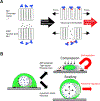Components and Mechanisms of Nuclear Mechanotransduction
- PMID: 34213953
- PMCID: PMC8662532
- DOI: 10.1146/annurev-cellbio-120319-030049
Components and Mechanisms of Nuclear Mechanotransduction
Abstract
The cell nucleus is best known as the container of the genome. Its envelope provides a barrier for passive macromolecule diffusion, which enhances the control of gene expression. As its largest and stiffest organelle, the nucleus also defines the minimal space requirements of a cell. Internal or external pressures that deform a cell to its physical limits cause a corresponding nuclear deformation. Evidence is consolidating that the nucleus, in addition to its genetic functions, serves as a physical sensing device for critical cell body deformation. Nuclear mechanotransduction allows cells to adapt their acute behaviors, mechanical stability, paracrine signaling, and fate to their physical surroundings. This review summarizes the basic chemical and mechanical properties of nuclear components, and how these properties are thought to be utilized for mechanosensing.
Keywords: chromatin; lamina; laminopathy; mechanotransduction; nuclear membrane; nucleus; progeria.
Figures


References
-
- Aebi U, Cohn J, Buhle L, Gerace L. 1986. The nuclear lamina is a meshwork of intermediate-type filaments. Nature 323(6088):560–64 - PubMed
-
- Akter R, Rivas D, Geneau G, Drissi H, Duque G. 2009. Effect of lamin A/C knockdown on osteoblast differentiation and function. J. Bone Miner. Res 24(2):283–93 - PubMed
-
- Amulic B, Knackstedt SL, Abu Abed U, Deigendesch N, Harbort CJ, et al. 2017. Cell-cycle proteins control production of neutrophil extracellular traps. Dev. Cell 43(4):449–62.e5 - PubMed
Publication types
MeSH terms
Grants and funding
LinkOut - more resources
Full Text Sources
Research Materials

